The 1970s: FAPE in LRE
(The Right to a Free Appropriate Public Education in the Least Restrictive Environment)
In 1970, only one in five students with disabilities was educated in American schools. By 1975, the Bureau of Education for the Handicapped* was also saying that an estimated one million—children with significant disabilities were still totally excluded from the education system, and at least another 300,000 were not receiving adequate services.
Throughout the 1960s and into the 1970s, parents testified before state legislatures across the country to secure a free appropriate public education for their children. Changes emerged in some states and in some localities. This created a climate for change and a basis of experience. A number of court challenges extended the Civil Rights decisions since 1954 into the arena of people with disabilities.
In 1969, the judge in Fred G. Wolf et. al. v. The Legislature of the State of Utah ruled that "children with moderate mental retardation*" should be provided with an education through the public school system. "Segregation, even though perhaps well intentioned, under the apparent sanction of law and state authority has a tendency to retard* the educational, emotional, and mental development of the children."
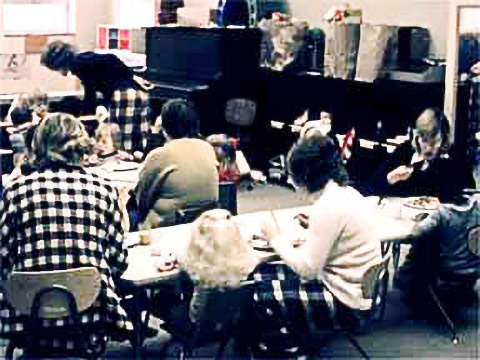
Photo courtesy William Bronston, M.D.
The biggest breakthrough came in 1971. Attorney Thomas K. Gilhool represented the Pennsylvania Association for Retarded* Citizens v. Commonwealth of Pennsylvania (PARC v. Commonwealth) in a case that resulted in a landmark decision. The court affirmed the right to education at public expense and due process for children with disabilities. Gilhool used Brown v. Board of Education in his arguments. Twenty-seven federal court cases followed and led to the birth of P. L. 94-142, the most influential law that mandated that right.
PARC v Commonwealth was restricted to all "children with mental retardation*." In the same year, Mills v Board of Education of District of Columbia affirmed the Pennsylvania decision and expanded its application to all children with disabilities.
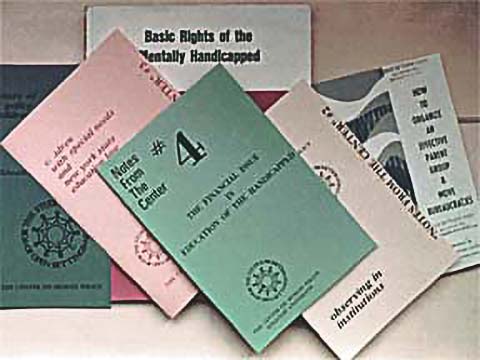
Photos courtesy William Bronston, M.D.
Describing the "Least Restricted Environment"
The court decisions did not use "least restrictive environment," but certainly described it. The Pennsylvania settlement said:
Placement in a general school is preferable to placement in a special school class is preferable to placement in any other type of program of education and training.
The court cases of the early 1970s that focused on institutions did use "least restrictive environment" explicitly.
Following on the court decisions, a number of federal laws between 1973 and 1975 strengthened the civil rights protections related to education.

Photos courtesy William Bronston, M.D.
The Rehabilitation Act of 1973 (P.L. 93-112) was (and is) critical because it addressed discrimination against persons with disabilities. Section 504 provides qualified individuals with disabilities with basic civil rights protection in programs and activities that receive federal financial assistance.
The law states that "no otherwise qualified disabled individual in the United States… shall, solely by reason of a disability, be excluded from the participation in, be denied the benefits of, or be subjected to discrimination under any program or activity receiving federal financial assistance." Since 1965, education was one of the many programs receiving federal financial assistance.
The U.S. Department of Education regulations to implement Section 504 prohibit discrimination against children and youth with disabilities in educational institutions receiving federal funds. Agencies that persist in acts of discrimination face the loss of federal funds. The prohibition applies to preschool, elementary, secondary, postsecondary, vocational, and other programs and activities that receive or benefit from federal financial assistance.
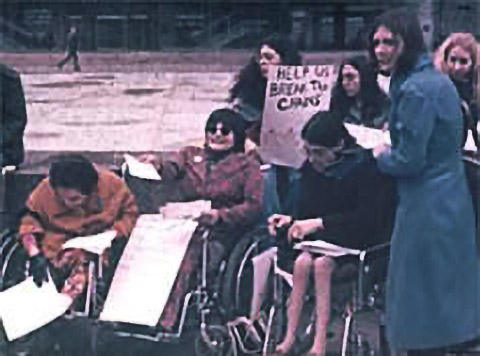
Photo courtesy William Bronston, M.D.
As a result of the U. S. Supreme Court cases, the states were under considerable pressure to provide such services and they lobbied Congress to assist them. Congress began an investigation into the education of children with disabilities. While more than eight million children needed special education, it was found that only 3.9 million were receiving an appropriate education. Some 1.75 million children with disabilities were receiving no education at all, while 2.5 million were receiving an inappropriate education.
The Education Amendments of 1974 (P.L. 93-380) contained a variety of changes to existing federal education programs under the Elementary and Secondary Education Act (ESEA). Title VI of the ESEA was renamed the Education of the Handicapped Act Amendments of 1974. States were required to establish a timetable toward achieving full educational opportunity for all children with disabilities.
The Act provided procedural safeguards for use in the identification, evaluation, and placement of children with disabilities; mandated that such children be integrated into general classes when possible; and required assurances that testing and evaluation materials be selected and administered on a nondiscriminatory basis. The Act passed.
As Alan Gartner notes, "A disorderly mix of state laws and local practices, along with growing pressure from parent advocates, influenced officials of the newly established Bureau of Education for the Handicapped* to support the 1974 amendments to the Elementary and Secondary Education Act."

Photo courtesy William Bronston, M.D.
In 1975 the Education for All Handicapped* Children Act (P.L.94-142) was created which mandated free, appropriate public education in the least restrictive environment. Individualized Education Programs (IEPs) were also mandated with special education and related services designed to meet the unique individual needs of each child. This was the most landmark special education law enacted up until this point since it was for all children and youth with disabilities.
Public Law 94-142 was basically a state grant program which contained specific requirements that the states had to follow in order to receive federal funds.
The major purposes of P.L. 94-142 were:
- To guarantee that a "free appropriate education," including special education and related service programming, is available to all children and youth with disabilities who require it.
- To ensure that the rights of children and youth with disabilities and their parents or guardians are protected (e.g., fairness, appropriateness, and due process in decision-making about providing special education and related services to children and youth with disabilities).
- To assess and ensure the effectiveness of special education at all levels of government.
- To financially assist the efforts of state and local governments in providing full educational opportunities to all children and youth with disabilities through the use of federal funds.
The companion legislation (the Developmental Disabilities Assistance and Bill of Rights Act) also supported the least restrictive environment (LRE) principle. Children who were not currently receiving a public education were to get first priority in the use of federal funds by states. The regulations enacting P. L. 94-142 became effective in 1977. States were initially given until 1978 to implement the regulations but this was later extended to 1981.
One of the major impacts of P. L. 94-142 was to increasingly prevent the institutionalization of children. One provision of P. L. 94-142 required states to establish priorities for providing a free appropriate education to all children [with developmental disabilities]… first with respect to children who are not receiving an education, and second with respect to children, within each disability, with most significant disabilities, who are receiving an inadequate education…
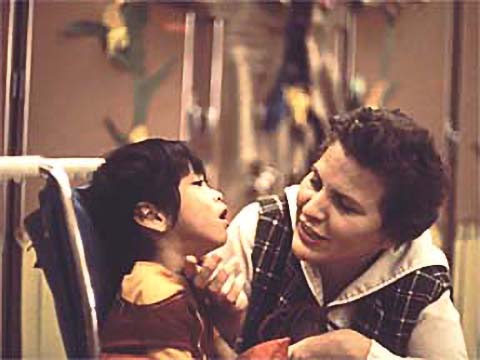
Photo courtesy William Bronston, M.D.
"Child Find" Systems
States were required to develop and implement "child find" systems. When word got out about the availability of a public education, some parents saw they had an alternative to the physicians' recommendations to institutionalize their children. As Val Bradley comments, this had a powerful effect on the capacity of families to stay together.
If we mark progress in our field by those events that bolstered the ability of people with disabilities to remain and thrive in their communities, then the passage of the Education for All Handicapped Children's Act was probably the singularly most important piece of federal legislation. Working in family support over the years, I can't count the numbers of people I've met who were forced to place their family member in an institution because they couldn't bear up under the stress of caring for a son or daughter with disabilities for 24 hours a day – the result of the exclusion of children with disabilities from from general public school.
(private communication)
Basically, P. L. 94-142 guaranteed the right of children with disabilities into the public education system, not necessarily into the schools and classrooms where children without disabilities went.
Public Law 94-142 was certainly a major human rights break through. In a court decision about exclusionary zoning against group homes, the U. S. Supreme Court decision included an analysis of the history of segregation and the importance of P. L. 94-142.
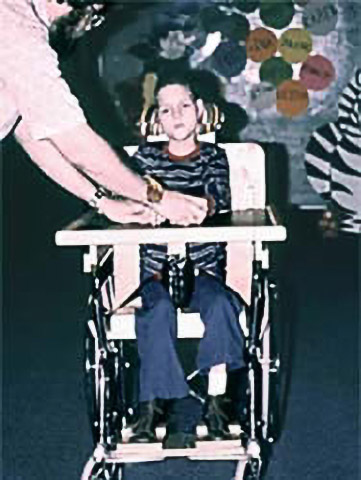
Photo courtesy William Bronston, M.D.
"By the latter part of the 19th century and during the first decades of the new one, social views of people with disabilities underwent a radical transformation… [a] regime of state-mandated segregation and degradation soon emerged that in its virulence and bigotry rivaled, and indeed paralleled, the worse excesses of Jim Crow… Children with disabilities were categorically excluded from public schools, based on the false stereotype that all were uneducable and on the purported need to protect children [without disabilities] from them.
The Education of the Handicapped* Act Opens the Doors of Public Education
In 1985, the Court observed: "Prejudice, once let loose, is not easily cabined… Not until Congress enacted the Education of the Handicapped* Act were the doors of public education opened wide to children with disabilities. But most important, lengthy and continuing isolation of people with disabilities has perpetuated the ignorance, irrational fears, and stereotyping that long have plagued them."
By 1977, The Arc US was arguing that most, but not all, of the options along the continuum of least restrictive environments should be included in the general school:
- The least restrictive environment for a child [with mild disabilities*] might be the general classroom. The majority of his educational programming could be conducted in this setting, with some specialized instruction coming from other professionals… In most cases these specialists can train the general teacher to carry out the entire program…
- For a student [with significant disabilities], the most normal environment possible might be a self-contained classroom within a school that serves children [without disabilities]. This type of arrangement would allow the individual to receive the highly structured instruction necessary for his progress, while still allowing him to be exposed to children [without disabilities].
- Some children [with profound disabilities] may have problems so crippling that they are medically unable to attend classes in the traditional school setting because the trip to school endangers their lives.
The Arc US also acknowledged that many children with severe* and profound disabilities* lived in residential institutions, where they had to same right to education under P. L. 94-142. State education agencies were required to assume at least general supervision of the educational programs within institutions. Those educational programs had to be provided in the least restrictive environment.
In 1977, The Arc US recognized that it would take some time for the guarantees of P. L. 94-142 to be implemented in institutions. In 1981, The United States General Accounting Office soon realized that the implementation of P. L. 94-142 in the community would take some time.

Photo courtesy William Bronston, M.D.
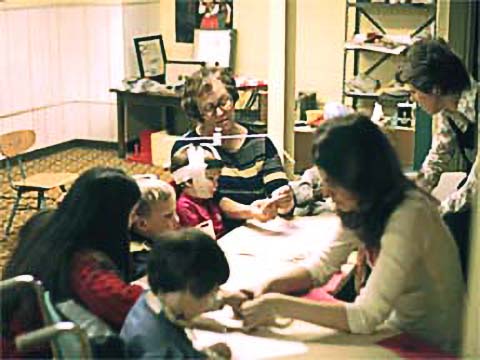
Photo courtesy William Bronston, M.D

